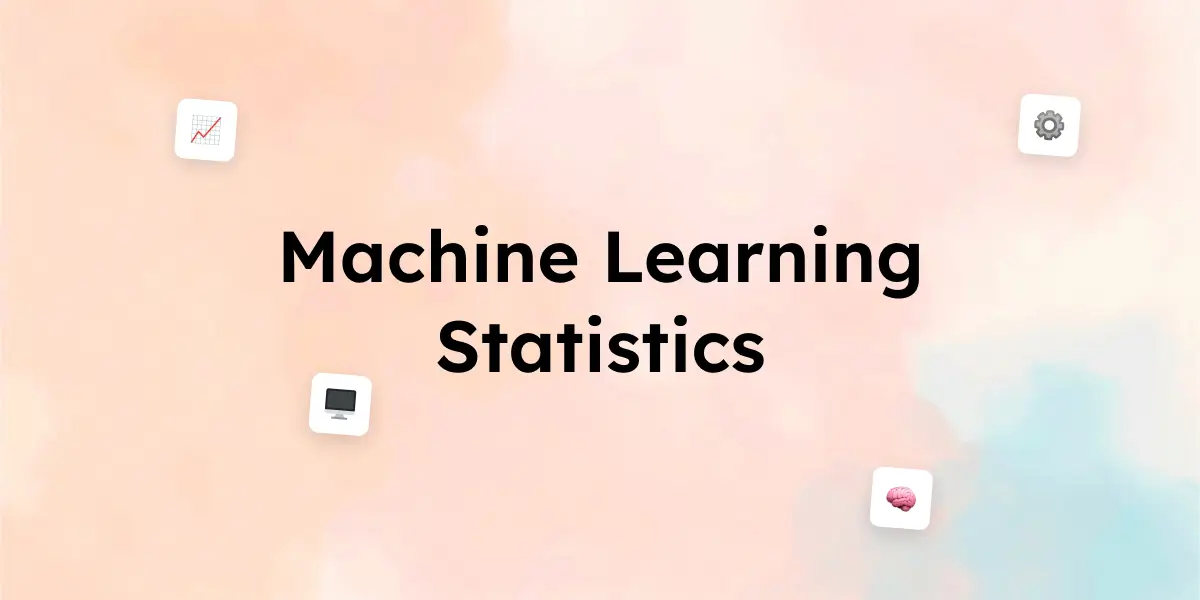Machine learning is reshaping industries, automating complex tasks, and driving innovation at an unprecedented pace. In 2025, AI adoption is at an all-time high, with businesses leveraging advanced algorithms for everything from healthcare diagnostics to financial forecasting. Whether you’re an AI enthusiast, data scientist, or entrepreneur, staying informed about key ML statistics will give you an edge in this fast-moving landscape. Here are 40+ essential machine learning statistics you need to know this year!
40+ Machine Learning Statistics
1. Machine Learning Market & Industry Growth 📈
- The global machine learning market is projected to reach $225 billion by 2030, growing at a CAGR of 35.6% .
- 77% of businesses are either using or exploring AI and machine learning for operational efficiency .
- The AI industry is expected to contribute $15.7 trillion to the global economy by 2030 .
- 40% of enterprises will automate at least 50% of their IT operations using AI/ML by 2026.
- AI startups received $120+ billion in funding in 2024, a 25% increase from the previous year .
2. Adoption & Real-World Applications ⚙️
- 90% of leading companies have ongoing AI investments.
- 50% of enterprises are using ML for fraud detection and cybersecurity.
- Retailers using AI-powered demand forecasting have seen a 15-30% reduction in inventory costs .
- AI-powered recommendation engines drive 35% of Amazon’s total revenue.
- AI is expected to handle 95% of customer interactions by 2027, up from 60% in 2023.
3. Performance of ML Algorithms 🧠
- Transformer-based models like GPT-5 and Gemini Ultra have achieved 98%+ accuracy in NLP tasks.
- The error rate in computer vision tasks dropped from 26% in 2011 to 2.5% in 2024, outperforming humans.
- The accuracy of AI-powered medical diagnosis has reached 92% for detecting cancers, surpassing human radiologists.
- Deep learning models can now process data 10x faster than models from 2020 due to better hardware and algorithms.
- The use of explainable AI (XAI) in ML models has increased by 35%, improving transparency
4. ML in Business & Productivity 💼
- AI-powered chatbots save businesses $8 billion annually in customer service costs.
- Companies using ML for marketing see a 30%+ improvement in customer engagement.
- AI-powered sales forecasting models are 20% more accurate than traditional methods
- 75% of CFOs say AI is essential for financial planning and forecasting.
- AI-driven automation could cut operational costs by 20-30% in sectors like manufacturing and logistics .
5. Bias, Ethics, and AI Regulation ⚖️
- 56% of AI practitioners worry about bias in machine learning models.
- 80% of AI companies are investing in AI ethics and responsible AI frameworks.
- The EU AI Act, set to be enforced in 2025, will categorize AI systems based on risk levels.
- Facial recognition AI still has a 20-30% higher error rate when identifying people with darker skin tones .
- China and the U.S. account for 70% of global AI research papers published annually.
6. AI Hardware & Computing Power 🖥️
- AI training costs have decreased by 50% since 2022, thanks to new AI chips like NVIDIA’s H100 and Google’s TPU v5.
- Quantum computing AI models can now solve problems in seconds that take classical ML models days .
- The cost of training GPT-5 exceeded $100 million, a 10x increase compared to GPT-3.
- AI-powered edge computing is growing, with 75% of enterprise-generated data expected to be processed at the edge by 2027.
- AI data centers consume 20-50x more energy than traditional data centers.
7. Job Market & AI Skills 🏆
- Demand for AI and ML engineers has grown by 74% year-over-year.
- AI-related jobs pay 30-50% higher salaries than traditional tech roles.
- By 2026, 50% of workers will need AI-related upskilling to stay relevant in their fields.
- Python remains the #1 language for ML, followed by R and Julia.
- Top ML job roles in 2025: AI Ethics Officer, Prompt Engineer, AI Product Manager, and Deep Learning Researcher.
8. Future Trends in Machine Learning 🔮
- Self-supervised learning is expected to reduce reliance on labeled data by 60% in the next three years.
- AI-generated content (text, images, and video) will make up 90% of digital content by 2030.
- Neurosymbolic AI (combining symbolic reasoning and deep learning) is gaining traction for explainability.
- AI-powered drug discovery has cut research time by 50%, accelerating vaccine development (Nature).
- Multimodal AI models (text, image, audio) are 3x more effective in understanding complex inputs than single-modal models (DeepMind).
- AI-driven digital twins are being used in smart cities to optimize urban planning and reduce congestion.
Conclusion
The world of machine learning is evolving rapidly, with breakthroughs in model accuracy, computing power, and real-world applications. As AI becomes more integrated into daily life, understanding these trends is crucial for both professionals and enthusiasts. Whether it’s the rise of multimodal AI, the ethical challenges of bias, or the explosive growth of AI-powered automation, one thing is certain—machine learning is here to stay, and its impact will only grow.
Frequently Asked Questions
1. What industries benefit the most from machine learning in 2025?
ML is revolutionizing healthcare, finance, retail, manufacturing, and cybersecurity. AI-powered diagnosis, fraud detection, personalized recommendations, and predictive maintenance are some key applications.
2. What’s the biggest challenge in machine learning today?
The biggest challenges include data privacy, AI bias, model explainability, and high computational costs. Ensuring ethical AI development while improving efficiency remains a priority.
3. What is the most popular machine learning model in 2025?
Transformer-based models (like GPT-5 and Gemini Ultra) dominate in NLP, while self-supervised learning and multimodal AI are gaining traction across industries.
4. Is machine learning replacing jobs?
While ML automates repetitive tasks, it also creates new roles in AI development, ethics, and automation management. Upskilling in AI-related fields is crucial for staying competitive.
5. How can I start learning machine learning in 2025?
Start with Python, TensorFlow, and PyTorch, and explore online courses from platforms like Coursera, Udacity, and Kaggle. Hands-on projects and real-world applications are key to mastering ML.
Sources & References
Fortune Business Insights
Stanford AI Index Report
Harvard Business Review (HBR)
Juniper Research
OpenAI & DeepMind Reports



